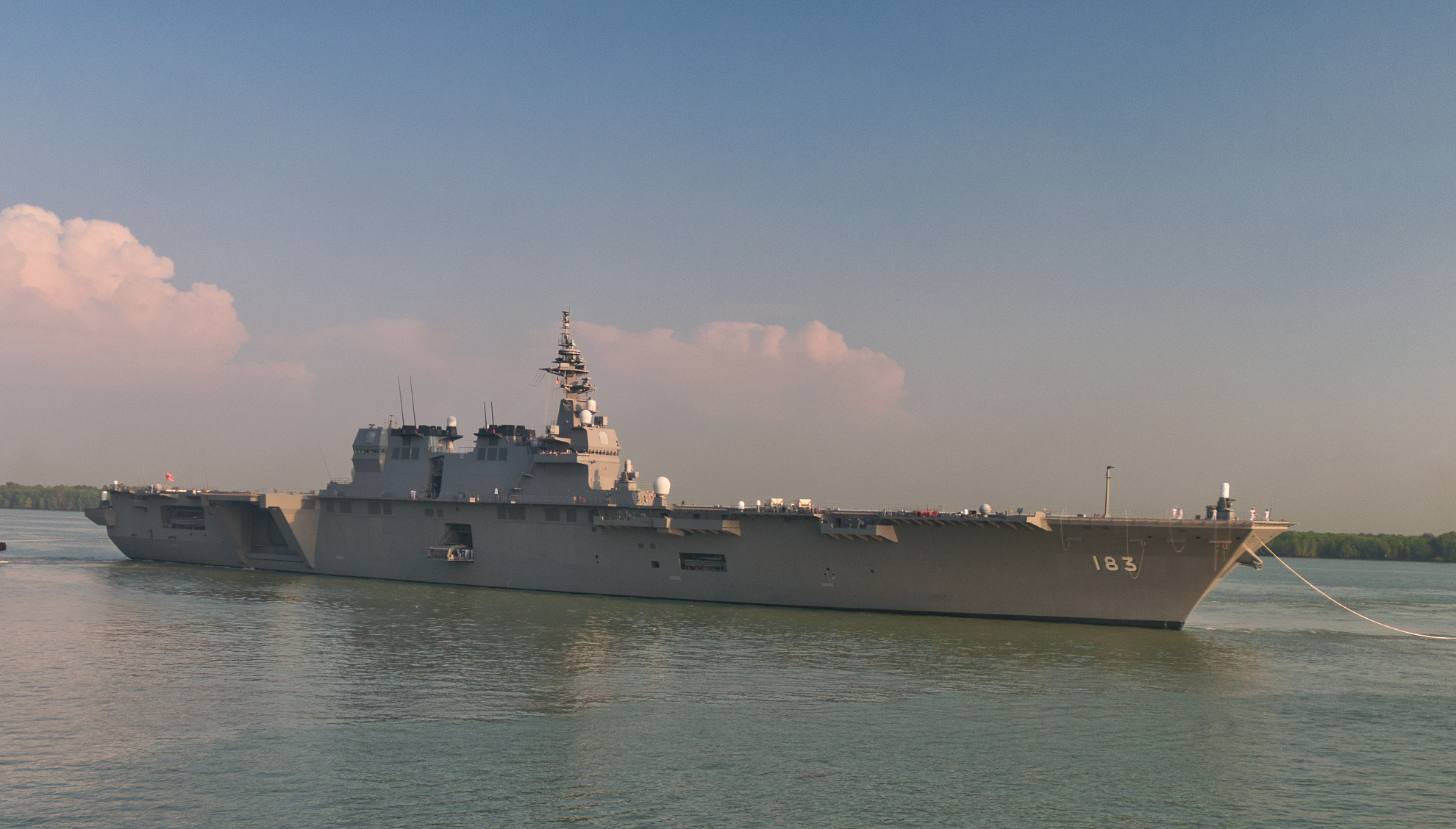
SHAH ALAM: Japan’s biggest warship, helicopter destroyer, JS Izumo – DDH183 — arrives in Port Klang, this morning. Izumo which is on four-day port call in Malaysia was escorted by another destroyer, JS Murasame – DD101.
The two vessels, part of the Escort Flotilla 1 of the Japan Maritime Self Defense Force (JMSDF) are in Port Klang, for port call and replenishment after they participated in ADMM plus maritime security field exercise 2019 and IMDEX 2019, which was held in Singapore. Both had also conducted an exercise with the Indian Navy and the French Navy carrier, Charles De Gaulle in the Bay of Bengal, prior coming to Malaysia.
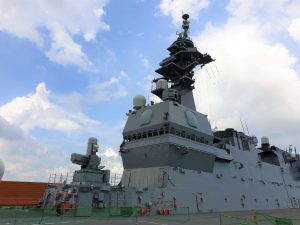
Escort Flotilla 1 of JMSDF is commanded by Rear Admiral Hiroshi Egawa. The two vessels carried about 590 crew members on board. This was the first time the Izumo, that would be classified as a helicopter carrier by other navies, had berthed in Malaysia.
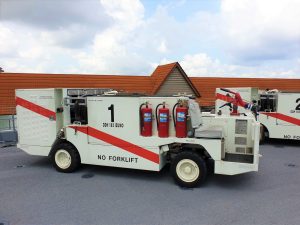
In a press conference held on board Izumo, Egawa said a Humanitarian Assistance and Disaster Recovery seminar will be held on May 28 on board the ship.
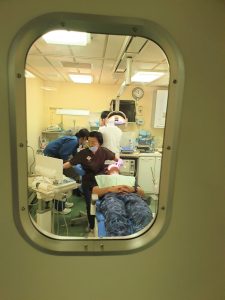
The seminar is held to enhance the bilateral defense cooperation between the Malaysian Armed Forces and the Japan Self-Defence Forces (JSDF) and the basis for further cooperation between both militaries.
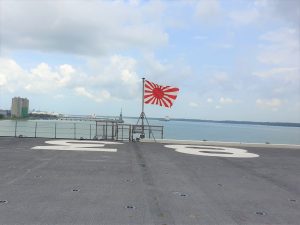
RMN Deputy Chief Vice Admiral Khairul Anuar Yahya who was present at the press conference, said the port call was a further display the close cooperation between both navies.
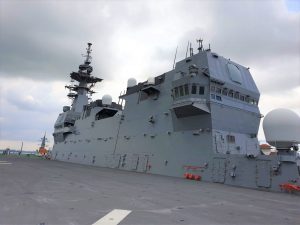
Asked whether they planned to conduct helicopter deck landing qualifications and other activities with the JMSDF vessels during their visit to Malaysia, Khairul Anuar said such event need further planning before it could be implemented.
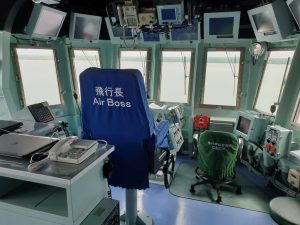
It is likely to be conducted during future visits to Malaysia by JMSDF, he said adding that it would not only involve the navy but also the RMAF as well.
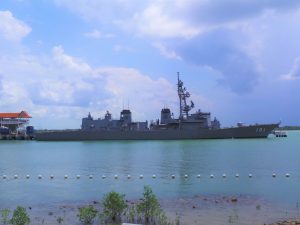
Both vessels are not open to the public during the port of call, though invited guests, mostly Japanese citizens were allowed on the Murasame shortly after she berthed at the Boustead Cruise Center.
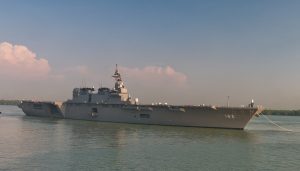
Meanwhile, as Izumo and Murasame berthed at Port Klang, Defence Minister Mohammad Sabu visited Charles De Gaulle as she sailed through the Malacca Straits on her way for a port call in Singapore later this week.
— Malaysian Defence
If you like this post, buy me an espresso. Paypal Payment

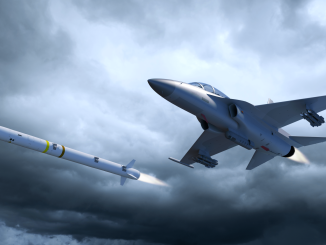
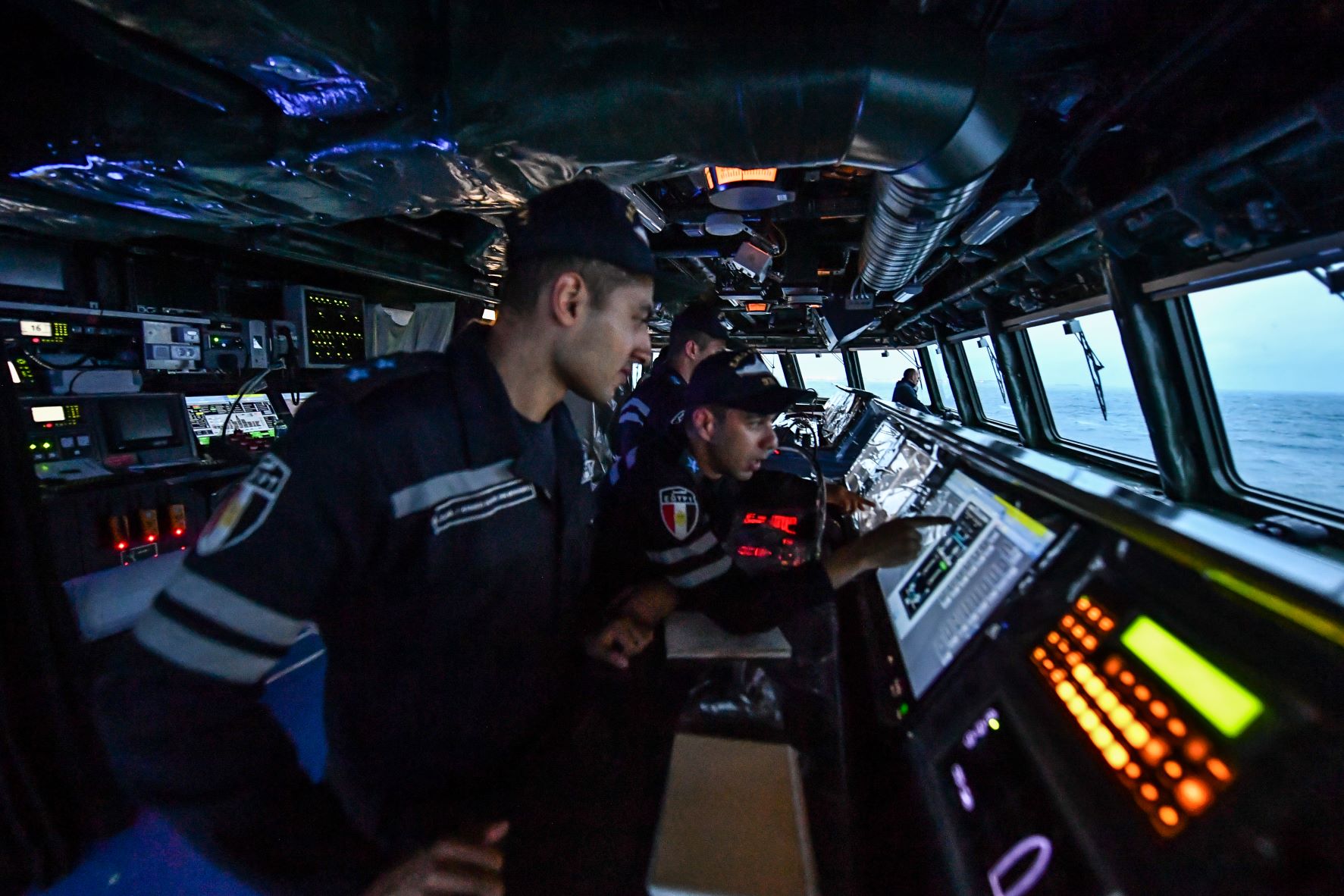
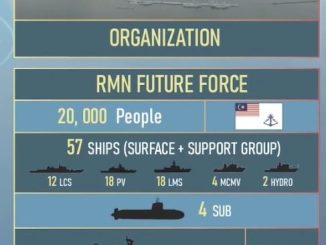
Did any TLDM ship conduct passex with CDG while the Menhan was on board in selat melaka?
IMO it should be made a point that any major warship passing through selat melaka should be welcomed and escorted by a TLDM ship
Reply
No idea, there was the MalFran Ex but nothing has been released so far about it
I’m thinking of a very scaled down Izumo for our MRSS requirement. Will Abe likely parley and part fund it?
Reply
Not really about Japan, it is more likely government not interested
MRSS? Its more of no money, and there is no smaller izumo design on the drawing board right now.
Anyway, this ship (picture below) is being retired this year, its sister ship next year. Are we willing to go secondhand? These ships are of the same size as the Makassar LPD, so it should be managable to operate.
http://www.magnum-x.pl/files/2018/NTW/1-2018/Giorgio.jpg
Off topic –
I’ve noticed the PT-91M has additional equipment and vents on the left rear hull, around the exhaust. on most other PT-91 or any T-72 derivatives. Was wondering if this an upgraded air conditioner or alternator. My feeling is our Renk powerpack does not require such changes.
https://en.wikipedia.org/wiki/File:PT-91M_tank_of_the_Malaysian_army.jpg
for comparison against
http://www.btvt.narod.ru/raznoe/erawa/ERAWA.htm
@ AM
Probably the aircon system. The same box also a feature of the PT-91EX.
There is also a new higher box on the same location but on the right hand side for an auxillary power unit (for static operation, no need to switch on main engine) offered as an upgrade by bumar.
http://m.imgur.com/69skWac
http://3.bp.blogspot.com/-6mPBqrz2xWs/WbBPSgnzqGI/AAAAAAAAA6Q/zloCXseUEl4BnExaVr5ePtoZ9jRckVLtgCLcBGAs/s1600/MSPO%2BPT-91M2%2Bmit%2BAPU.png
Government not interested due to the high price (even for a scale down one). But if Japan is willing to part fund it (and maybe barter trade for palm oil?), who knows if they might think about it.
@…
At the moment, yes there’s no smaller design available. But then it might be possible to scale it down. As for secondhand, marine-wise TLDM & MMEA have never been adverse to that idea unless the purchase & refurb cost is unjustifiable. Only of the past couple of decades we have been getting new due to “national service” of building them locally.
@ joe
Izumo is an aircraft (now just helicopter, later with J-35) carrier. What MRSS should be is a multi-purpose ship with amphibious support capability. If you want to go japanese, the Osumi-class LST design is a better fit for the mission.
http://upload.wikimedia.org/wikipedia/commons/3/39/LST-4002.jpg
Anyway IMO we have plenty of shipbuilding “national service” in our hands; Gowinds, MMEA OPV, MMEA NGPV, submarine refit, FAC upgrade/refit and others.
So IMO with our tight financial resources it is no big issue if we get 2x MRSS ships 2nd hand, and it is probably more acceptable politically than buying Makassar LPD (which is a good design too) from indonesia.
@ marhalim
Just browsed old topics, 10 years talking about MRSS on malaysiandefence, and still no sign of anything moving forward. And we must still talk about the MRCA for at least 10 more years into the future LoL! Hopefully will still be alive by then.
https://www.malaysiandefence.com/lima-part-iii/
@…
Yup your right. Something like the Osumi would be interesting if the prices can be made right.
FYI, we are outsiders just kopitiam talking. Some take it too seriously and thought those in power are listening. I highly doubt it. They have their own plans and agenda whether they be from the old government or the new one.
@…
Not in this current \”no money\” situation the country is facing, as far as we all know those MRSS, MRCA, LCA or even a second batch tank brigade won\’t be possible in the near future. Not now. Welp, make do with what we have I guess.
…
If our tanks don’t have an APU, it would be a very useful and not too expensive upgrade.
Likewise the cage armour for areas not covered by ERAWA, just like in your pic and on this T-72B3.
https://pbs.twimg.com/media/C8rZC49VwAEkH_b.jpg
On whether a scaled down Ozumo would interest us : no. Just like how a scaled down Dokdo didn’t suit our requirements. We don’t need something to project power or to be an aviation or command platform.
We need a “jack of all trades” design like the Makassar or similar designs; to do various things in line with our specific requirements and threat perceptions. Also something that can berth in most of our bases and won’t cost an arm and leg to support.
Not too long ago a neighbouring country bought a mini carrier and a small number of fighters to go along with it; mostly for prestige reasons. The fighters quickly became inoperable because they were too expensive to maintain and spares became an issue as the years passed. The actual ship was never fully fitted out, hardly put to sea due to costs and wasn’t even suitable for HADR.
@ am
Yes the APU would be a good upgrade for our PT-91M.
As for cage armour, IMO this is effective only against RPG, dont see many instances we are going against RPG equipped enemy on our own soil. Looks cool, but will be easily snagged with our jungle vegetation.
@ omarion, joe
Why we talk about defence here? Because unlike those in the system who worries about career advancement, being blinded by offers from weapon suppliers, thinking about politics etc etc we (well I) mostly talk things that could better our defence without any of the above points. Plenty of other blogs, fb pages that does not talk about defence seriously, or have very impartial view on it, but here it is mostly open, and without distraction of overly political or nonsense point of views. Probably now we dont have the money, but there is always an option that we can take to counter that problem. Plan your future taking into account for no (or little) money, rather than planning (or dreaming) with imaginery money in the sky.
@ azlan
Yes in the MRSS we need a “jack of all trades” ship, as that is what our Mahawangsa is too. IMO that would be all the things Mahawangsa can do plus a helicopter hangar, and well dock. That would be the Makassar LPD, IMO the best compromise of need and cost for the capability.
Small LPD flat tops like Osumi and San Giorgio lacks hangar space due to the small size.
The Makassar LPD with the political baggage of buying indonesian defence products, and the near future availability of used San Giorgio class of LPD (1st 2019,2nd 2020 and 3rd 2022) IMO those are the 2 platform that is ideal for MRSS.
As for our BM5 and BM6 auxillary ships, could it be modified (with minimal cost) into something like this?
https://pbs.twimg.com/media/CIOA81OWIAALgOM.jpg
@…
Man proposes, but God disposes. In this case, us civilians proposes, but those in power will ultimately disposes as they wish.
Its a good discussion, and its good to share. Just that like any other forums, we shouldn’t take it too seriously as if we expect Mindef to take what we said as the only truth.
…….
On the contrary there is a huge demand for protection against shoulder fired weapons given that engagements – in places like estates and build up areas – will be at close ranges and can come from directions in which the tank is especially vulnerable, even from above (flyovers, buildings, etc). Our landscape and rapid urbanisation clearly shows that a lot of engagements will take place in restricted terrain.
If we had lots of wide open areas (non restrictive terrain) where engagements would take place at longer ranges and where the enemy would mostly be attacking from the front; then protection against shoulder fired weapons would be a lesser concern but this is clearly not the case. Also cage armour can be useful in mitigating the effects of auto cannon fire and ATGWs. The fact remains that unless one wants to up armour a whole vehicle 360 degrees or fit every single MBT and IFV with a APS; there is no more practical and cheaper solution than bar/cage armour/chicken wire.
We have gone through this before. When people mention “RPGs” what they mostly mean is any shoulder fired weapon. They don’t strictly mean just “RPGs” despite only mentioning “RPGs”. As for snagging, a lot of things can get snagged; a MG mounting, aerials, side ERA modules, etc, not just bar/cage armour/chicken wire. It’s just something we have to put up with.
Joe,
A problem is that whilst a lot of things would seem logical or economical on paper to outsiders; there will be various factors at play not known to us. Not only funding but inter service rivalry, outside interference and politics. At times also, the services would rather wait longer rather than get a stop gap solution as this might lead to even longer delays on the part of the government.
At times the services might present an affordable solution to the government but it is the government that drops the idea and insists on a better (also more expensive) solution despite not being able to give an indication as to when funding will be available. Yet people will assume that is the services which won’t be flexible by accepting something cheaper.
Bear in mind that before a requirement is approved at MINDEF and registered at Finance; the services have to provide ample justification on why they need something and all angles (including the relationship with the foreign country, how the local industry will benefit, etc) will be thoroughly looked at.
I’ve been told that the questions and excuses questions asked can sometimes be silly, like : “ why do you need more frigates when you already have a few?”, “you have gone without an AEW for decades, why do you need one now?” We’re not in a state of tensions with anyone”, “yes we understand you need such and such to monitor the Spratlys but there is no cash and the Foreign Ministry has been told by China that what they’re are doing is just for domestic Chinese consumption; so don’t worry!”, etc.
Also, the San Giorgio class does look well suited for the job but like all things, will they be priced reasonably and are we going to expect a bidding war with other nations that have the money? Pushing Italy to accept barter with palm oil won’t do us any favour either, as they are the main proponent for EU to ban palm oil.
However, if we can lock in all 3 ships, that would be the most ideal scenario as we can base 1 each at West Coast, East Coast, and Sabah. That will ensure at least 1 ship can be quickly tasked to respond in any situation.
1. No doubt with HADR timing is vital but it’s important to note that unlike the Philippines or Indonesia we are not a archipelagic nation with remote areas that are only easily accessible by sea. Even in cases of bad floods here for instance; there is still access via land routes.
2. Assuming we have to lift large numbers of troops or cargo; having 3 ships at different locations will be a huge problem as they’ll have to brought to one place where the people and equipment can be embarked. Time consuming. There is a reason why although combatants tend to be deployed at various bases, most countries tend to group their lift/amphibious assets together, as far as possible. In our context having 3 MPSSs at different locations can also lead to shore support issues.
3. The age of the ships may be a worrying factor; especially for a cost constrained navy like ours. Sure, they may be in good condition and may have plenty of life left but given their age; how much will they cost to operate, how much will operating costs increase over the years due to age, wear and tear and obsolescence and how many major parts/components will need replacing in the coming years? The actual procurement costs may turn out to be the least of our concerns.
4. The most practical and cost effective solution – when the government finally allocates funding – is to get a newly built design like the Makssar or something similar.
@…
Re: Modifying container ships
Apparently all those modifications already take up most of the cost anyway. And then there are other considerations such as lifespan of commercial vessels vs military-built.
@joe
Playing fantasy fleets; 2 ships would be sufficient. It’s possible to design them such that each ship is available for duties at least half the year, so we can guarantee at least one year-round coverage with just 2 ships.
To build a ship just for HADR response is easy; you just need a heli hangar, well deck, lots of cargo space, hospital, water maker, crisis management facilities.
To build a ship that can do all that AND convert to troop ferrying for wartime – that’s where the cost comes in. Cause now you need to turn it into a Warship that can survive enemy action.
@ chua
“To build a ship that can do all that AND convert to troop ferrying for wartime”
We need to define what is “war” that we can manage.
Against non-state actors/pirates? Yes
Actions under UN mandate in a multi-country coalition? Yes
Retaking malaysian islands from insurgents? Yes
Waging war against other countries? No
Even if we have the MRSS to full military standards, with the profileration of anti-ship missiles and missile armed destroyers in asia pacific, the chance of a surface ship surviving a fight in an all out war is slim. IMO why we should not bother going for full military standards of anything floating on the surface other than our top end frigates.
@Azlan
Yup. We are outsiders looking in. Often we cannot fathom the decision or indecision made because we didn’t know the other factors are at played and swayed the decision. Which is why I say, no need for us to get too upset about their decision or indecision, although I generally would be quite angry if we had missed getting something beneficial just because of indecision.
@Chua
It depends on the doctrine for what they are used for. FYI it will take half a day to 1 day for ships to traverse from Lumut to Kuantan or Kuantan to Sabah & vice versa. If HADR is the main priority for these ships (they are more likely to be transporting help into disaster zones rather than trooping to conflict), then they should be ready to respond as soonest possible at either sides of our coasts. A 1 day lag time could mean more lives being lost. Of course ideally one should be in refit & maintenance on rotational basis.
@ joe
For HADR purposes, able to deploy a ship within 48 hours to anywhere within malaysian or south east asian waters is good enough IMO. any faster that would be the task of our A400Ms.
What examples to we have to benchmark?
KD Pahang was on location in java sea just 24 hours after air asia indonesia flight QZ8501 crashed.
http://www.thestar.com.my/news/nation/2015/01/15/royal-navy-successfully-completes-qz8501-mission/
In 2004 Acheh Tsunami, KD Mahawangsa and Inderapura took 2 days to sail from port klang to acheh.
Chia,
Just because a ship is a “military spec” one doesn’t mean it has a longer lifespan than a commercial one. Many commercial tankers and transporters are actually built to higher/ tougher standards than naval ones.
On the basing of future MPSSs; it depends on bases having the needed shore support infrastructure and jetties able to take their draught. It would be nice if every base had its own mixed flotilla; comprising say a couple of LCSs, a couple of LMSs and a MPSS but not all our bases have the needed shore support infrastructure and we don’t have the numbers.
Years ago the RN came up with the idea of having mixed flotillas; each comprising several frigates and MCMVs; they could because they have the numbers and the shore support infrastructure in place.
Logic dictates we base all our MPSSs at the same base (we only will have a handful and they are not frigates in that they don’t perform routine day to day tasks requiring them to put to sea with the same regularity). This simplifies a lot of things; not to say that they can’t or won’t be forward deployed or temporarily based elsewhere for short durations.
Chua – “Cause now you need to turn it into a Warship that can survive enemy action”
No……..
“You” need a ship that is purposed designed and equipped to deliver people and equipment from Point A to Point B; whether the destination is a port with all the needed facilities or a beach. This a commercial ship cant do just as well. As I’ve pointed out before however, when it comes to delivering stuff to a fully equipped port, a commercial ship can do the job just as well.
“You” also need this ship to be fitted – if possible – with a self defence suit but at the end of the day; whether it’s a commercial ship or a LST, it must have an escort in time of war. Just because it’s military ship doesn’t necessarily mean it can better “survive enemy action”. A depends on the level of damage control standards a customer is willing to pay for.
@…
It is “good enough” for the current capabilities we have, but if we had sufficient MRSS, can we do better? Instead of 48hrs, can we respond to crisis within SCS areas in 24hrs? While ideally we have the A400Ms to rely on quick response, sometimes there are no sufficient airfield to cater for A400M or it might be inoperable.
@ joe
Simple. HADR is not our no1 priority for MRSS. If it is, better paint it orange with big “rescue” on the side of the ship.
…
>”We need to define what is “war” that we can manage”
Yes, this is something I’ve mentioned here before.
Since even pirates can have access to advanced missiles these days, or we might fight with rebels who have stolen advanced ATGMs from other armies, the barest minimum a HVT like our MRSS should carry is a CIWS system and chaff launchers, right? Plus upgraded damage control systems, more watertight compartmentalisation and frag protection over key areas? MRSS should also have command facilities with the associated sensors, SATCOM and so on right?
The costs of all that would add up to basically purpose-building an MRSS.
“HADR” is one of the roles the RMN constantly says the MPSS can perform, true but this is more to justify funding. Just like how a few years ago the RMAF touted a AEW’s peacetime utility in the hope this would convince the bureaucrats to release funding.
Similarly we often hear how a MPSS can support UN missions but we don’t have UN missions all over the place and it’s cheaper and more practical to use a commercial ship; which we did.
Sure HADR can be performed by the MPSS but in Malaysia most areas hit by natural disasters are still accessible by land or sea. We’re not the Philippines or Indonesia; both archipelagic states with far flung remote areas. Like the Saktis a MPSS can deliver humanitarian aid abroad but this is not the main reason we’re going to buy it and a commercial ship can do the same job just as well.
Do we need a MPSS. Yes but lets not fall under the illusion that HADR is the main reason. The MPSS’s value will be when it is required to deliver men or gear to a place without proper port facilities and for that it will also need helicopters and landing craft. A MPSS without the needed helos and landing craft won’t provide the desired or needed capability.
@… & @Azlan
If TLDM were to emphasise on the ‘military’ purpose of MRSS and not on the ‘HADR’ or ‘peacetime logistics’ purpose, you can bet they are either not going to get it soon or get too few to be sufficiently needed. We have to see reality of the situation that TLDM needs something else in justifying to the bureaucrats holding the pursestrings.
Joe,
Yes obviously but let’s not delude ourselves that the main purpose the MPSS is being sought is for HADR or that HADR will be its primary role.
You spoke about the “reality of the situation” in justifying funding: which I already explained very clearly in my previous post. Nobody said the RMN was taking the wrong approach in the way it tried to gain MPSS funding.
Chua,
A MPSS should have some form of self defence but it also should always be with an escort in times of conflict or tension. Nice to have CIWS or a point defence missile system but these things can take up a sizeable portion of the budget.
Command facilities are also nice to have and make a good sell but can also a absorb a chunk of the budget. We need the bare minimum to do what we need it for, nothing more Anything more will be superfluous. A SATCOM capability is standard on every RMN ship.
@ joe
Of course it can do HADR, but that is SECONDARY to its military mission.
Your want for 24h depoyment target/goal/kpi for HADR means HADR equipment must always be on standby stored on board the ship ready to go. To do that the ship main task and training need to be on HADR.
48h reaction time is good enough for a secondary task.
@ joe
Everyone must clearly understand that main task of the military is to deter and fight any adversary that threatens malaysian interests. We should never try to suggest otherwise, like what mat sabu did here.
https://www.malaysiandefence.com/defence-white-paper-why/#comment-375945
Of course MRSS can do HADR, but that is SECONDARY to its military mission, and never should it be a primary reason to the government. Another reason why we badly need the DWP, so that all relevant parties understand the importance of national defence and the military does not need to come out with phony reasons to buy new equipment.
Your want for 24h depoyment target/goal/kpi for HADR will mean that HADR is the primary task and HADR equipment must always be on standby stored on board the ship ready to go. To do that the ship main operations and training need to be on HADR.
48h reaction time IMO is good enough for a secondary task.
.
@Azlan
True. Very true.
P.S. I had a much longer reply but it seems long comments don’t get through the spam filter.
“Since even pirates can have access to advanced missiles these days, or we might fight with rebels who have stolen advanced ATGMs from other armies, the barest minimum a HVT like our MRSS should carry is a CIWS system and chaff launchers, right? ”
To be precise, non-state groups have done one better than using ATGMs and successfully used “conventional” active radar guided ASMs to date. INS Hanit was attacked by Hezbollah and UAE-leased HSV-2 Swift was attacked by the Houthis, both with C-802 that China sold to Iran or the Iranian clone Noor.
Of course, many such groups are well availed with ATGMs, an attack has already happened and others are a matter of time- IS hit an Egyptian patrol boat off Sinai with a Kornet. It is clear though that radar chaff would not have fooled a SACLOS ATGM.
What could have helped in those situations were intel, a good state of readiness, good SA from sensors, greater freedom of maneuver, opsec and deception measures, in addition to countermeasures such as chaff. Without these things (which are not always present when talking about a terrorist attack in peacetime) the presence of chaff launchers, Nulka, ECM or even escorts for our MRSS is not likely to save us from missile attack. Well equipped warships have taken hits because something hadn’t been done right. Contrast these with the attacks USS Mason fended off in 2016, then consider that state-level actions will be much more sophisticated.
While on the subject, here’s a good explanation of the patterns of chaff and their purposes.
https://www.quora.com/There-is-an-incoming-anti-ship-missile-The-ship-activates-its-chaff-At-that-point-can-the-ship%E2%80%99s-radar-still-track-the-threat
Chua,
If the MPSS has a 57 or 76mm mount in the “A” position, we should count ourselves lucky.
Who knows? To save cash they might be be forced to go for a 20 or 30mm mount. A gun that size, on a ship that size, will be an eye sore. Or they might not even have anything in the “A” position and just have a pair of 20 or 30mms amidships.
With the exception of the LMS everything we’ve bought has been gold plated; high spec systems/components. Look at the Kedahs for example, they might not have been armed as intended but they were fitted with various high end systems/components. Maybe this will turn out to be the case too with the MPSS too.
Still very early days to see the long term approach this government will take with defence. One things’s for sure : someone else is badly needed to head MINDEF. If the Defence Minister continues to “underperform” and continues to hold the same position, the only person we can blame is his boss.
There was also the incident when Royal Marines in South Georgia used a Carl Gustav (which we deploy with the RMN in the Spratlys) on an Argentine ship.
Like the Stark, the Hanit when it was hit wasn’t prepared. The CIWS was even on standby. In our context, what’s worrying is that when operating in littoral environment, close to the shores and islands, a ship has very little time to react against a incoming ASM.
In times of conflict or tension a ship will be on standby but in peace time; a surprise attack will catch a ship not expecting trouble, with its self defence suite switched off. Ships are very also vulnerable. Disable a radar and a ship is blind. Damage to a fire director will render the main gun inoperable – all modern gun mounts are not able to be operated manually from inside the cupola.
We can go even further and say that an opponent using a virus to disable a CMS and a ship’s comms will also render the ship non combat capable. Sure like other navies the RMN still retains the basics like the old school plotting table/charts and morse code but the fact remains that all the high tech electronics on a ship can also be its Achilles heel.
Turning on close-in active defence during peacetime will endanger civil and friendly aircraft flying around the ship.
@… & @Azlan
While it is a warship, an MRSS isn’t expected to be at the front lines of conflict. Those jobs are for better protected ships otherwise something as big as an MRSS is a fat juicy target. Outright warships like frigates & corvettes also have some HADR capacity but their roles is overwhelmingly for fighting, and thus equipped so. MRSS roles are a bit more blurry in that they are flexible ships capable to ferry troops & equipment as well as a mobile base & disaster recovery. The PRIMARY role doesn’t overwhelmingly cast a long shadow over the SECONDARY roles so TLDM could try to be smart in ‘marketing’ the flexible duties of the MRSS.
I’m not saying their efforts to get MRSS is anything wrong but what their doing currently JUST ISN’T WORKING. With a government that thinks we are very unlikely to go to war, the heads must stop pushing the military role of what they are asking for. Lateral thinking is needed here.
Reply
RMN has been talking about the HADR role for the MRSS, if I remember correctly, since 20 years ago. It might be called differently back then but it was for the same thing.
Joe,
I don’t really get the point you’re trying to make. We seem to be going around in circles and complicating things when they’re not. I’ll keep things simple.
1. The primary role of the MPSS is not and has never been HADR. If stuff has to be delivered to a port, commercial ship can do it just as well, if not better.
2. From the 1980’s when we got the Saktis; the RMN has always made clear that one of the roles the MPSS can and will perform – if needed – is HADR.
3. The RMN has made its case quite well. The government has never disputed the need for a new MPSS; funding is the issue. That is why it hasn’t been realised yet; not because of a lack of “lateral thinking” as you so boldly and confidently claim. The RMN has had a requirement for a new MPSS since the late 1990’s, even when it had the Inderapura.
4. It may be a big target but in times of war or tensions; a MPSS will ALWAYS (I’m following your practice of going upper case) an escort. Thus the fact that it’s a big “fat juicy target” shouldn’t arise.
……
True or not; I’ve been told or heard somewhere that when it’s on automatic mode; Phalanx is so “sensitive” that it targets sea gulls.
Even in wartime however (depending on the circumstances) even when set on auto mode, a gun or missile system still requires a human to actually press the button.
“If the MPSS has a 57 or 76mm mount in the “A” position, we should count ourselves lucky.
Who knows? To save cash they might be be forced to go for a 20 or 30mm mount. A gun that size, on a ship that size, will be an eye sore. Or they might not even have anything in the “A” position and just have a pair of 20 or 30mms amidships.”
But should we hope to have a 57 or 76mm mount over a 20 or 30mm? Most navies would say no and have not fitted such guns because they are neither here nor there- larger than necessary to take on small boats, yet insufficient to allow the ship to do away with escorts.
The defensive suites of amphibious type ships fall into three broad categories. Those with autocannon and maybe MANPADS (eg Makassar, Endurance) as an economy measure, those that additionally have gun or missile CIWS (Dokdo, Izumo, almost all USN types) which add to the close-in defences provided by the escorts, and those with an area air defence suite (Kalaat Béni Abbès, Hyuga) which are intended to provide self escort capability up to a point and even help protect fellow ships in the task group.
These ships will never be risked without escorts and the escorts will have sufficient 57, 76 and even 127mm A guns between themselves, so the “big” guns can be left off the amphib. One can argue that there is no such thing as too much protection, but I would not resent not having an A gun because there would be enough of those on our other ships.
The only amphib around today with a big gun is the Endurance class. Even then, when its successor JMMS arrives, it will almost certainly leave this off in favour of one of the latter two options.
This HADR masquerade is overrated. Sure it sweetens the pitch but it’s not like the EPU and finance ministry are stupid.
” Lateral thinking is needed here ”
You are really barking up the wrong tree.
There is nothing wrong with the current TLDM reasoning for the MRSS, and the government is accepting the fact that TLDM needs those ships. The only problem now is the fulus or lack thereof.
AM,
The addition of any self defence weapon is to supplement whatever protection escorts provide and is a last ditch option in case of leakers. Fitted with the right ammo a 57 or 76mm provides some level of hard kill defence against missiles.
A 20 or 30mm mount will only be useful against stuff like small surface units; which by right shouldn’t be allowed to get too close if the escorts are doing their job. Depending on the circumstances and how much one is willing to spend. It can also be argued that if a 57mm or 76mm mount is beyond the budget; a 20 it 30mm is better than nothing and is useful against peacetime asymmetrical threats
One can always point out that no expense should be spared to ensuring a high value asset is adequately equipped to defend itself and to complement its escorts. On the other hand funds are tight and we are unlikely to find ourselves in a position where a MPSS would need the same level of self defence as USN equivalents.
Personally I feel that at a bare minimum the MPSS should have a 57 or 76mm. mount. Sure together with a fire director this will cost millions but it provides greater operational flexibility/utility than a 20 or 30mm mount.
“The addition of any self defence weapon is to supplement whatever protection escorts provide and is a last ditch option in case of leakers. Fitted with the right ammo a 57 or 76mm provides some level of hard kill defence against missiles. ”
Okay, but why a 57 or 76mm gun and not a dedicated CIWS for the CIWS role? Almost every navy thinks these are better for dealing with leakers.
As for the 57mm gun.
There has been advances in smart shell systems like the MAD-FIRES that is cheaper than a dedicated CIWS. Why IMO getting the bofors 57mm was a smart move for the gowinds.
http://www.overtdefense.com/2019/05/08/mad-fires-57mm-shell-may-provide-expanded-capabilities-to-navys-mk-110-guns/
Reply
The only problem is that the ammo for them are very expensive
@ marhalim
” The only problem is that the ammo for them are very expensive ”
” MAD-FIRES was envisioned by DARPA as a low cost system, suitable for widespread deployment and usage against a wide variety of threats. The guided shell should be able to engage a variety of targets at lower cost than a RIM-116 Rolling Airframe Missile or RIM-66/156 Standard Missile ”
Reply
Still very expensive for a cannon shell. Though I agree it might be cheap for the US Navy
AM.
We can put a CIWS in the “A” position like what the Israelis do but the main value of a small calibre CIWS is more in dealing with missiles that have got really close, small surface craft, etc. Having a 57 or 76mm gun provides more flexibility. It can engage targets at longer ranges, can cause more damage to larger ships, etc. A 57 or 76mm mount on a MPSS can also provide NGFS – if needed – during landing/amphib ops.
At the end of the day a CIWS (whether gun or missile) is supposed to be operated in conjunction with a main gun and other stuff; as a complement. It also defends part of the ship not covered by the main gun.
Very few navies rely on just a CIWS as the main means of defence and if they do it’s because their ships are intended to be operated under a strong air umbrella and with high end escorts. In our case we are unlikely to be in a position where we can arm a MPSS with a main gun, CiWS and missile system. Unlike many others whose CIWSs operate with other systems; whatever gun we put on the MPSS will be its main or only means of self defence.
Ideally a MPSS will have a main gun and a CIWS but the reality is that this won’t happen. We can’t afford it. Thus the best we can realistically hope for is a main gun and perhaps a couple of 20 or 30mm guns amidships.
The Israelis put a CIWS in A gun because those corvettes of theirs will be charging in to deliver SSMs and expect to face enemy SSMs head-on.
On a large support ship like an MRSS, arguably it doesn’t matter so long as there is 360 coverage.
An Oto 76mm with Vulcano is actually better than a Phalanx or Goalkeeper “dedicated” CIWS.
https://www.defensenews.com/naval/2019/06/10/uae-naval-group-quietly-cut-850-million-deal-for-gowind-ships
@ AM
Important take from that announcement.
The UAE gowinds are to be armed with ESSM, linking into the SETIS CMS. So probably not too late for the maharajalelas to be armed with ESSM.
Smaller than our own 3100-ton version?
Price about the same still, even with all the inflation. And using Exocet and ESSM instead.
RMN wanted Tacticos (for commonality with the Lekius) and ESSM but was overruled.
AM,
Another case of the local industry being allowed to have its way.
The Lekius are fitted with NAUTIS.
Chua,
No……. It’s mainly because the Israelis know that in any war chances are they will have air superiority and that there is less of a need for a main gun deal with aircraft or missives and more of a need for Phalanx – with its higher ROF – to deal with missiles.
One doesn’t need a CIWS in the “A” position to deal with head on threats as threats seldom come from head on and ships normally manoeuvre to bring into position their weapons.
On Vulcan being better than Phalanx or Goalkeeoer; this really remains to be seen. Each system will have its respective merits and their OEMs will claim their product is the most ideal.
@Azlan
The Israeli design choice is based on their combat experiences when they did indeed face P-15 Termits head-on.
Vulcano has performed better in tests.
Azlan “The Lekius are fitted with NAUTIS.”
Yes, the RMN wanted Tacticos for commonality with the Kasturis, which were being backfitted with it at the time the LCS were ordered.
Chua “An Oto 76mm with Vulcano is actually better than a Phalanx or Goalkeeper “dedicated” CIWS.”
Yes but you’ll need a radar like Smart S or Herakles for the Oto to take on missiles and it’s not likely we’ll go for one. The CIWS will perform better when you have such a radar, but can still work without.
Azlan “One doesn’t need a CIWS in the “A” position to deal with head on threats as threats seldom come from head on and ships normally manoeuvre to bring into position their weapons. ”
Chua “The Israelis put a CIWS in A gun because those corvettes of theirs will be charging in to deliver SSMs and expect to face enemy SSMs head-on. On a large support ship like an MRSS, arguably it doesn’t matter so long as there is 360 coverage.”
One has to prioritise even with “360 degree coverage,” not that all round coverage is necessarily what you’d go for.
Ships will attempt to present the smallest aspect when under attack. We see plenty of combatants sporting CIWS in pairs with unobstructed, overlapping coverage of the rear but with less coverage in other directions and none for the bow. Those ships will present the stern, yet there are others that split the difference with one system forward and one aft, recognising that there isn’t always time to maneuver as such.
Whatever layout or number of CIWS we choose, its survival rests on the quality of its escort (among other things).
Chua,
Missiles seldom engage a target head on. Look at the Falklands, Iran/Iraq war, Georgia/Russia war, etc. can you find any examples of a missile striking a ship head on? As I said, ships manoeuvre to position their weapons.
Vulkano performed well in “tests” no doubt; so did Phalanx, Goalkeeper, Millennium, Kahstan and RAM but the key word is “tests”.
AM – “ts survival rests on the quality of its escort (among other things)“
A lot depends on how much warming is given to alert crews of an incoming ASM and how well the escorts and coordinate their efforts. Ideally not only will there be a layered hard kill option but also a soft kill option.
Also, unlike older gen ASMs which had unsophisticated seekers which homed in on the closest or largest radar echo; current gen ones have very discriminatory seekers and their flight paths can be programmed to hit certain parts of a ship and to arrive from different directions and intervals; to saturate one’s defences.
Azlan:
It’s not about where the missile coming from. It’s about presenting the smallest target to the incoming missile. If you look at, say Arleigh Burke, there’re 2 Phalanx at B and X position. One for the frontal 180 and one for the rear 180. Ships maneuver to present as small a target which is frontal/rear, and at the same time bring the CIWS into position.
Hornet Lover,
This thing about ships manoeuvring to present the smallest target worked well against older ASMs; not very effective however against the seekers of current gen ones.
Yes navies place CIWSs in the A and B positions but it’s to deal with threats coming from various angles whilst the ship is manoeuvring to place its weapons in the best position and and also to deploy chaff – by and large ASM don’t come head on.